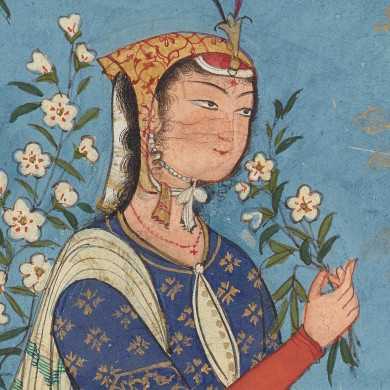
Detail of a 1575 Persian Safavid miniature (courtesy the Freer Gallery of Art)
Cities of jasmine, roses of beloveds: scent, identity, and culture in the Middle East
The wind picks up the scent of the water and its surroundings. The sea breeze catapults my memories back to the Corniche in Beirut: grilled corn, the faint aroma of lemon lingering in the sweet and salty air. A breeze of fresh pine finds its way south from the mountains. It fills me with a deep longing for home, yet satisfies me. Those scents, images, and feelings are forever imprinted in my memory and identity. I know I am not the only one, though, for scent plays a prominent role in the culture of the Middle East. Traditions, rituals, and countries in the region, it can be said, have in part developed through a sense of smell.
Similar memories of Beirut are also recalled in a song (Aranis) from the album Cheftak by the Lebanese indie duo Soap Kills. The first part of the song refers to aranis, a word commonly used to refer to grilled or boiled corn-on-the-cob in Lebanon. On the track,Yasmine Hamdan recreated the image of the Corniche in Beirut, with all its various sounds and smells. Come closer to the good smell, the deliciousness / The touch of my lips, try them … Watermelon on the knife, she sang. In another bit of the song, Hamdan quoted words written by the Lebanese singer Omar al-Zanni in the 1940s dealing with the changing conditions of the city, the new face of postwar Beirut, and nostalgia for the past.
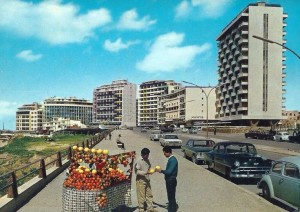
Being invisible, scents trigger memories deep in the subconscious, and send subliminal messages. They are also associated with hanan (‘tenderness’ in Arabic) and love. In the Middle East, perfumes are revered to a high degree, and have seemingly evolved along with changes in the way people sense smells. There is also an evident link between scents in a particular environment and geographic locations – even moments in time – and how people behave on both an individual and collective level. With there being such a strong expression of identity through the sense of smell, it is almost impossible to separate one from the other. For example, one can consider commonplace greetings in places like Cairo and others in the Arab world: sabah el ful wel yasmeen,they say, which translates to ‘[may you] have a morning full of jasmines and jasmine sambac’.
Floral scents and imagery, on the whole, are incredibly prominent in the culture of not only the Arab world, but also North Africa, Turkey, and the Persianate world. Roses, jasmines, and other flowers are loaded with many meanings and metaphors all throughout the region. For instance, the tulip is the national flower of Turkey, while the rose is that of Iran, wherein it has long served as a metaphor in Persian Sufi literature. The scent and image of the jasmine flower (from the Persian yasmeen) in particular has long united peoples of the Middle East, and has created an almost shared olfactory landscape resulting in subconscious and shared experiences. Damascus is known as the ‘City of Jasmine’, and the flower is also strongly associated with Tunisia. In 1987, it acted as a symbol of freedom and evolution and the new leadership, and was again at the forefront of the 2011 uprisings dubbed the ‘Jasmine Revolution’. There, the pairing of harrowing experiences to something beautiful formed a message that lived on through hope. The Jasmine Revolution was not the only political event in the region to be associated with scents, however; in 2005, Lebanon also saw its own: the Cedar Revolution.

As with the rose in the Persianate world, Arab artists have long made references to jasmines in their work. In Lebanese band Mashrou’ Leila’s Shim el Yasmeen, for instance, Hamed Sinno sings the verses smell the jasmine and taste the molasses and tahini, and remember to remember me … Smell the jasmine, and remember to forget me. As well, the renowned Syrian poet Nizar Qabbani also wrote odes to the flower. One of his first pieces of poetry was entitled The Jasmine Scent of Damascus, and his last book of poetry, Abjadiat el Yasmeen (The Jasmine Alphabet) was likewise dedicated to it. In the poem, Damascene Moon, an ode to Damascus, he penned his memories of his birthplace:
… For I am the Damascene, whose profession is passion,
Whose singing turns the herbs green;
A Damascene moon travels through my blood;
Nightingales … and grain … and domes.
From Damascus, jasmine begins its whiteness
And fragrances perfume themselves with her scent …
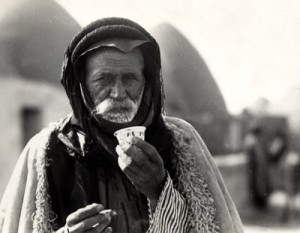
A Syrian Bedouin enjoying a cup of Arabic coffee in 1930
Elsewhere, in A Woman Walking Inside Me, the poet wrote the lines, everything can be denied but the scent of a woman that we love. Indeed, the connection between scent and memory is too transformational, one could argue, to ignore. Heavily inspired by Qabbani’s poetry, the rapper Omar Offendum in his 2009 song, Damascus, also invoked the image and scent of the jasmine flower. Minarets cryin’ tears of absence, an like trees their soul speaks, he sang; Years have passed them (you can hear them askin’) for civil rights to live amongst tears of jasmine … Elsewhere in the song, he paraphrases verses from Qabbani’s Damascene Poem, in which the latter made references to the aromas of coffee and cardamom: coffee grinders cracklin’ / childhood reminders … Cardamom’s strong fragrance … still finds attraction.
The scent and image of the jasmine flower has long united peoples of the Middle East, and has created an almost shared olfactory landscape resulting in subconscious and shared experiences
According to Offendum, Qabbani’s poem strongly resonated with him on a personal level, as it brought to mind memories of his mother cooking with cardamom. A multidimensional herb, it is used in both savoury and sweet dishes in the Middle East. As well, it is used in the preparation of Arabic coffee, whose aroma Offendum was regularly surrounded by as a child growing up in Saudi Arabia. As well, cardamom is oftentimes used in traditional Persian tea, also enjoyed throughout the region. Interesting to note, perhaps, is how differently the spice is used, and how varying the flavour it lends depending on geography.
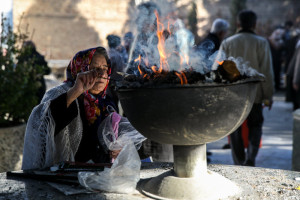
Also, of course, is oud, the scent of the agarwood tree that can be smelled all around the Gulf as well as many other places in the Middle East. It is heavy, resinous, opulent, and often associated with luxury. Its smoke is used to perfume homes, places of worship, wedding celebrations, and also, to ward off evil spirits. Oud has been used for generations in the Arab world, where it has played an integral role in traditional rituals, and long signified purity and hospitality. Likewise, in Iran and other countries such as Iraq, Syria, Jordan, and Saudi Arabia, esfand (Lat. Peganum Harmalaha, Gr. Persaia Botana; also known as wild rue, Syrian rue, African rue, and Harmal) is also used to repel the evil eye, as well as pain. Dried capsules of the flower are laid onto charcoal, releasing fragrant smoke amidst pops and crackles. The tradition has spanned many religions (e.g. Zoroastrianism and Islam) and cultures, and can be read about in early classical Persian literature.

In the Presence of Abscense Photo cityscents
As with memories of particular times and events, scents can also remind one of places, as Ashraf Osman of the Scent Culture Institute shows in his art project, Scents of Exile. Inspired by a eulogy the Palestinian poet Mahmoud Darwish wrote for himself in 2006, In the Presence of Absence, Osman’s project delves into issues surrounding olfactory memory, identity, and the nostalgia associated with cities in the Arab world and beyond. Broken down into two components, Scents of Exile comprises a curated exhibition that ‘showcases’ these scents on an international level and gives artists the opportunity to internalise its themes within the context of their own scent ‘experiences’. To quote Darwish: Cities are smells: Acre is the smell of marine iodine and spices; Haifa, the smell of pine and rumpled sheets; Moscow, the smell of vodka on ice; Cairo, the smell of mango and ginger; Beirut, the smell of sun, sea, smoke, and lemon; Paris, the smell of fresh bread, cheese, and the accoutrements of charm; Damascus, the smell of jasmine and dried fruits; Tunis, the smell of honeysuckle and salt; Rabat is the smell of henna, incense, and honey… And lands of exile have a common smell, which is that of longing for elsewhere. A smell remembering another, a smell of intermittent breaths, emotional, leading you like a tourist map that’s been used too often, to the smell of the first place.
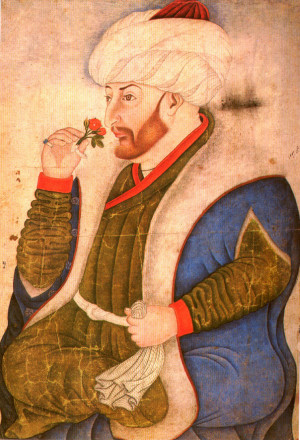
What does exile smell like? It is, perhaps, the scent of a melancholic desire of wanting, needing, longing for a way to return; a lucid moment of remembrance and comfort. Sometimes, this scent is all one has to hold onto. In a scene in the 2011 Moroccan film, The Five Seasons, Hanan, a blind character, expresses her love for the scent of rain. ‘Any smell I’ve smelled’, she says, ‘I remember it, because I know where I am by smells’. Likewise, scent has also played a considerable role in the music of Moroccan singer Hindi Zahra. When your kiss smells like love, when your heart brings tears and thrills, she sang in Kiss and Thrills from her debut album. The line so inspired me that I eventually created a perfume for her, the process of which involved taking elements of her song – timbre, pitch, tone, harmony, and melody – and translating its sentiments into smells. The result included a deep, floral Moroccan Rose oil, creamy sandalwood, and sharp, searing incense – scents that I felt would bring an essence of Morocco to Zahra, as well as translate the mood of the song and its words. Like her velvety voice and Bedouin charm, the scent is earthy and strong, while remaining sweet and vulnerable.
Today, artists from the region working in all fields are attempting to change the negative discourses associated with the Middle East and its peoples. The voices of many young and contemporary artists have emerged, veiled in the sweet memories of their childhoods, and steeped in intoxicating jasmine, rose, incense, saffron, oud, and esfand. This is, perhaps, what connects them – these memories reinforced by a sense of smell. Such sensory experiences have led to the creation of art of all forms, and a new way of seeing, feeling, belonging, and – smelling.
Dana El Masri, Guest Contributor
Dana El Masri is an independent perfumer, writer (this article was first published Reorient magazine), and musician. Her work focuses on scent, music, culture, and the intersections among the three. Dana is the winner of the UK’s Jasmine Literary Award, and is currently working on new perfumes for her brand, Jazmin Saraï, in addition to collaborating with artists and conducting research on scent and Arabic music.
